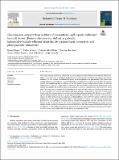Por favor, use este identificador para citar o enlazar a este item:
http://hdl.handle.net/10261/330755COMPARTIR / EXPORTAR:
 SHARE SHARE
 CORE
BASE CORE
BASE
|
|
| Visualizar otros formatos: MARC | Dublin Core | RDF | ORE | MODS | METS | DIDL | DATACITE | |

| Título: | Glucosinolate-extracts from residues of conventional and organic cultivated broccoli leaves (Brassica oleracea var. italica) as potential industrially-scalable efficient biopesticides against fungi, oomycetes and plant parasitic nematodes |
Autor: | Eugui, Daniel; Velasco Pazos, Pablo CSIC ORCID; Abril-Urías, Patricia; Escobar, Carolina; Gómez-Torres, Óscar; Caballero, Sara; Poveda, Jorge CSIC ORCID | Palabras clave: | Alternaria Brassicaceae Isothiocyanates Myrosinase Sustainable agriculture |
Fecha de publicación: | 9-may-2023 | Editor: | Elsevier BV | Citación: | Industrial Crops and Products 200: 116841 (2023) | Resumen: | This study aimed to standarize a protocol for obtaining a bioactive extract from broccoli (Brassica oleracea var. italica) crop residues, that is suitable for application on an industrial scale and effective in reducing plant disease incidence. For this purpose, the influence of several extraction factors in the glucosinolate (GSL) content was studied with leaves collected from two conventional broccoli fields and two organic broccoli fields. The analysis showed that lyophilization had no influence on the GSL content. Storage of plant material under two different temperatures (− 20ºC and − 80ºC) had no influence on the GSLs content of the extracts. Phytotoxicity of the extracts was studied with six different plant seeds, and also cytotoxicity was determined with human liver cells in vitro. The extracts were phytotoxic at dilutions above 10%, while cell toxicity was low. Extracts concentrations of 0.1%, 1% and 2% were tested in vitro against eight plant pathogenic fungi and two oomycetes in solid and in liquid media. The extracts reduced the growth of several plant pathogenic fungi at 2% dilution by up to 38.37% against Alternaria alternata and up to 46.55% against Sclerotinia sclerotiorum. When combined with myrosinase enzyme the effect of the extracts was enhanced, reaching inhibition values of 67.06% against A. alternata in solid medium and 68.52% against Rhizoctonia solani in liquid medium. In contrast, the same extracts increased the growth of the plant pathogenic oomycetes Pythium ultimum and Phytophthora cactorum. The effect of the same extracts in the free leaving larvae, J2s, of the plant-parasitic nematode (PPN) Meloidogyne javanica was not obvious. Minor significant differences were obtained but with no clear dose-response in nematode mortality, and no inhibition of eggs hatching was observed. These results show the industrial potential of using broccoli residues to obtain extracts with biopesticide activity against plant pathogenic fungi. | Descripción: | 16 páginas, 8 figuras | Versión del editor: | https://doi.org/10.1016/j.indcrop.2023.116841 | URI: | http://hdl.handle.net/10261/330755 | DOI: | 10.1016/j.indcrop.2023.116841 | ISSN: | 09266690 |
| Aparece en las colecciones: | (MBG) Artículos |
Ficheros en este ítem:
| Fichero | Descripción | Tamaño | Formato | |
|---|---|---|---|---|
| IndustrialCrops_2023_Glucosinolate.pdf | 4,2 MB | Adobe PDF |  Visualizar/Abrir |
CORE Recommender
SCOPUSTM
Citations
2
checked on 01-may-2024
WEB OF SCIENCETM
Citations
2
checked on 27-feb-2024
Page view(s)
44
checked on 03-may-2024
Download(s)
79
checked on 03-may-2024
Google ScholarTM
Check
Altmetric
Altmetric
Este item está licenciado bajo una Licencia Creative Commons



